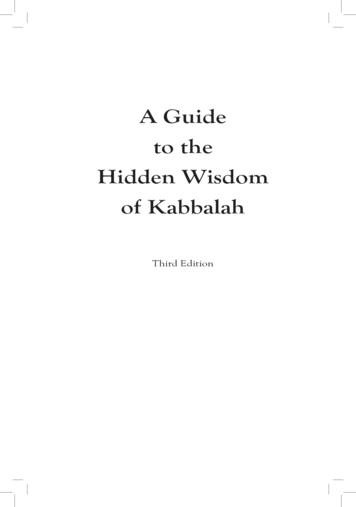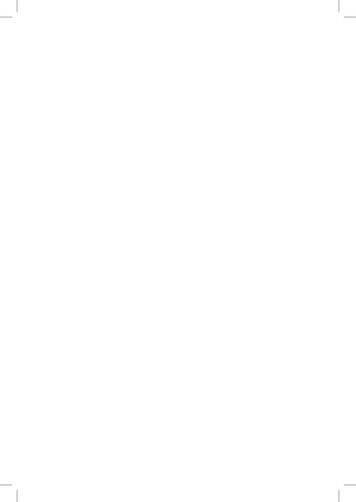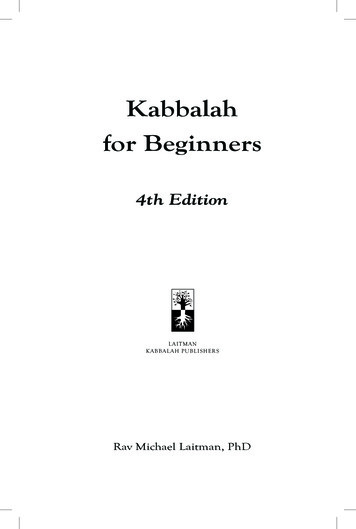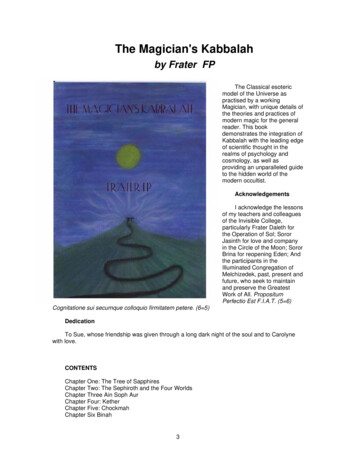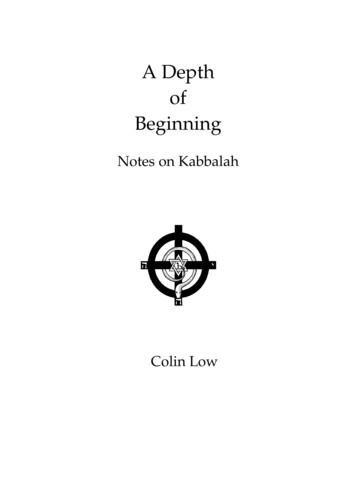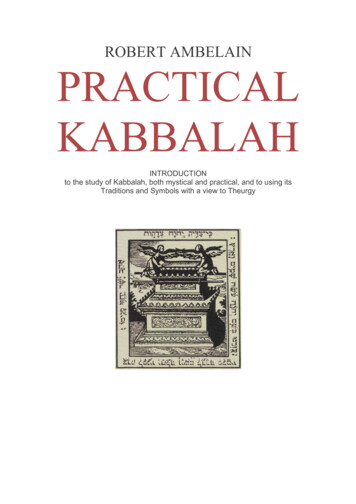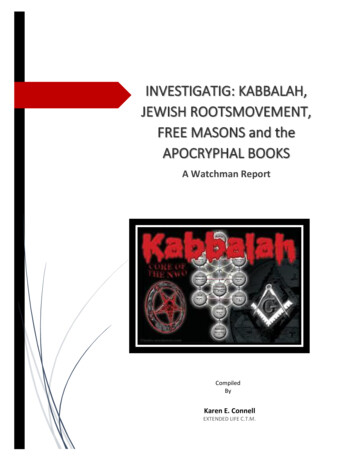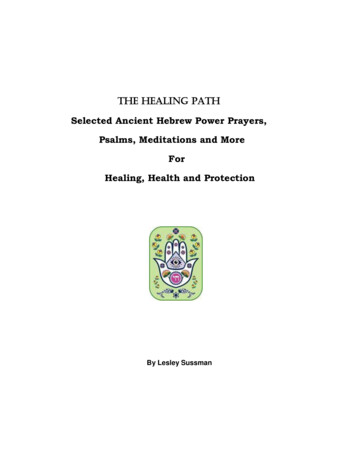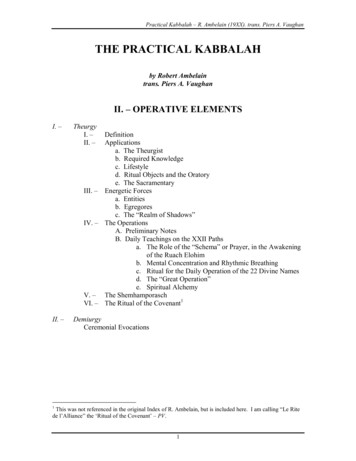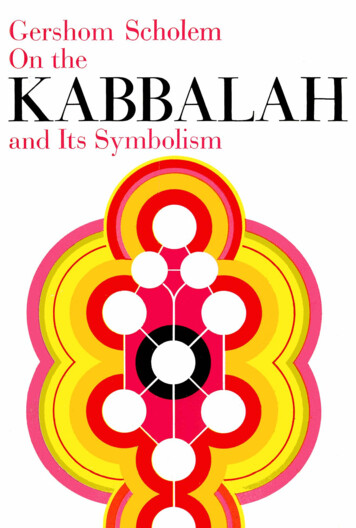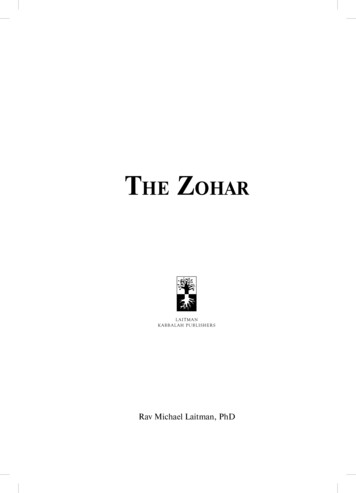
Transcription
THE ZOHARLAIT M A NKA BBA LAH P UBLISHERSRav Michael Laitman, PhD
THE ZOHARCopyright 2007 by MICHAEL LAITMANAll rights reservedPublished by Laitman Kabbalah Publisherswww.kabbalah.infoinfo@kabbalah.info1057 Steeles Avenue West, Suite 532, Toronto, ON, M2R 3X1, Canada194 Quentin Rd, 2nd floor, Brooklyn, New York, 11223, USAPrinted in IsraelNo part of this book may be used or reproduced in any manner without writtenpermission of the publisher, except in the case of brief quotations embodied incritical articles or reviews.Library of Congress Cataloging-in-Publication DataLaitman, Michael.The Zohar: annotations to the Ashlag commentary / Michael Laitman. -1st ed.p. cm.ISBN 978-1-897448-09-01. Ashlag, Yehudah. Perush ha-sulam. 2. Zohar. 3. Cabala. I. Title.BM525.A59A7755 2009296.1 62--dc222008015080Translation: David Brushin, Keren ApplebaumCopy Editors: Michael R. Kellogg, Mark BerelekhisEditorial Assistance: Leah GoldbergProofreading: Lily Solopov, Natasha Sigmund, Sarah TalalLayout: Luba VisotzkiDiagrams: Baruch Khovov, Luba VisotzkiCover Design: Bat Sheva BroshPrinting: Doron GoldinPost Production: Uri LaitmanExecutive Editor: Chaim RatzFIRST EDITION: FEBRUARY 2009First printing
TABLE OF CONTENTSPrologue .7About Rabbi Shimon Bar-Yochai .7Studying with Rabbi Akiva .8The Cave at Peqi’in .8The Idra Raba (Great Assembly) and The Book of Zohar .9The Reincarnation of a Unique Soul . 10Rashbi’s Departure. 10About The Book of Zohar . 11Removing the Covers .12Accelerating the Spread of the Wisdom .13Introduction .15List of Abbreviations and Explanations . 21Original Names and Their Equivalents Acceptedin the English Translation . 27Original Titles and Their Equivalents Acceptedin the English Translation .28An Example of the Original Text of The Zohar .29Literal Translation of the Aforecited Text from Aramaic into English .36The Rose . 41The Goal of Creation .45Sefirot .46Screen.48Partzuf .48The Inverse Proportion Between the Vessel and the Light .50The State of Katnut (Smallness) . 51The State of Gadlut (Greatness/adulthood).54Ascent of the Lower One to the Upper One .54The Light of ZON Is The Light of the Worlds BYA .55Correction in Three Lines .56Flower Buds .63Who Created These.73Who Created These (by Eliyahu) . 91The Mother Lends Her Clothes to Her Daughter . 101
The Letters of Rabbi Hamnuna-Saba . 117The Letters of the Hebrew Alphabet . 131Punctuation Marks in the Hebrew Alphabet (Nekudot) .134The Letter Tav . 143The Letter Shin. 148The Letters Kuf and Reish.153The Letter Tzadik .154The Letter Peh .156The Letter Ayin .158The Letter Samech .159The Letter Nun . 161The Letters Mem and Lamed . 163The Letter Chaf .164The Letter Yod .166The Letter Tet .168The Letter Zayin. 172The Letters Vav and Hey . 173The Letters Dalet and Gimel. 173The Letter Bet . 174The Letter Aleph . 175Supernal Wisdom . 179The Lock and the Key. 181Avraham . 189The Vision of Rabbi Chiya.193Who Is Your Partner? .209The Donkey Driver .223The Two Points . 271The Night of the Bride . 281Heaven and Earth . 315Among All the Sages of the Nations of the World,There Are None Like You. 337Who Is This? . 347He Who Rejoices on Holidays .355The Torah and Prayer .365Rabbi Shimon’s Departure from the Cave . 375The First Commandment. 379
The Second Commandment .385The Third Commandment .393The Fourth Commandment .399The Fifth Commandment .405The Sixth Commandment . 411The Seventh Commandment . 415The Eighth Commandment . 421The Ninth Commandment .427The Tenth Commandment .433The Eleventh Commandment .445The Twelfth Commandment .449The Thirteenth Commandment . 451The Fourteenth Commandment.453The Intention in the Prayer .465Raising a Prayer. 473Appendix One. Further Reading .507Appendix Two. About Bnei Baruch . 515How to Contact Bnei Baruch . 519
PROLOGUEA B O U T R A B B I S H I M O N B A R -YO C H A I 1In the second century CE, a single manwas granted the spiritual knowledge thatKabbalists had accumulated for 3,000years before his time. Rabbi ShimonBar-Yochai (Rashbi) put it all on paperand then hid it, as humanity was notready for it. Today, we are ready for therevelation of The Book of Zohar.Rabbi Shimon Bar-Yochai (Rashbi),author of The Book of Zohar (The Book ofRadiance) was a Tana—a great sage in the early Common Era centuries. Rashbi’sname is tied to numerous legends, and he is mentioned constantly in the Talmudand in the Midrash, the sacred Hebrew texts of his time. He lived in Sidon andin Meron, and established a seminary in the Western Galilee.Rashbi was born and raised in the Galilee (a mountainous region intoday’s Northern Israel). Even as a child, he was not like other children his age.Questions such as, “What is the purpose of my life?” “Who am I?” and “How isthe world built?” plagued him and demanded answers.In those days, life in Galilee was very harsh: the Romans persecuted Jewsand continually invented new laws to make their lives more difficult. Amongthese laws was a decree that prohibited Jews from studying the Torah (thensynonymous with Kabbalah).1The articles, “About Rabbi Shimon Bar-Yochai” and “About The Book of Zohar” are presentedhere courtesy of the paper Kabbalah Today.7
8THE ZOHARHowever, despite the Romans’ prohibition, Rashbi immersed himself in theKabbalah and tried to understand its subtle teachings. He felt that beneath theBiblical stories was a profound and hidden truth, which held the answers to hispersistent questions.Gradually, Rabbi Shimon came to realize that he had to find a teacherwho had already been through the spiritual path, gained experience, and couldguide others up the spiritual ladder. He decided to join the group of the greatestKabbalist of the time—Rabbi Akiva—a decision that turned out to be the turningpoint in Rashbi’s life.STUDYING WITH RABBI AKIVARabbi Shimon was an avid, devoted student, burning with desire to discoverthe Higher realms of reality. Before long, he was one of Rabbi Akiva’s primestudents. He studied with Rabbi Akiva for thirteen years, and achieved thehighest levels on the spiritual ladder.The Bar-Kokheva revolt abruptly ended the great days of Rabbi Akiva’sseminary. Almost all of his 24,000 students died in plagues, and in fierce battlesagainst the Romans. Of the 24,000 students, only five survived, and Rashbi wasamong them.Rashbi was among the leaders of the Bar-Kokheva revolt against the Romanrule in the land of Israel. His resistance became even more fierce and unyieldingwhen he’d learned how his teacher, Rabbi Akiva, had been ruthlessly executed.The Talmud writes that once, when Rashbi spoke against the Roman rule,a fellow Jew heard him and alerted the Roman authorities. In consequence,Rashbi was tried in absentia and was sentenced to death. The Roman emperorsent men in search of him, but to their disappointment, Rashbi seemed to havevanished into thin air.THE CAVE AT PEQI’INLegends have it that Rashbi and his son fled to the Galilee, hid in a cave atPeqi’in, a village in the north of Israel, and remained there for thirteen years.During that time, they delved in the secrets of the wisdom of the hidden. Theirefforts succeeded, and they discovered the entire system of creation.After thirteen years in a cave, Rashbi heard that the Roman emperor haddied. He could finally heave a sigh of relief. After leaving the cave, Rashbigathered nine students and went with them to a small cave in Meron, known as
PROLOGUE9The Idra Raba (Great Assembly). With their help, he wrote The Book of Zohar,the most important book of Kabbalah.Baal HaSulam described Rashbi and his students as the only beings whoachieved perfection, the 125 spiritual degrees that complete the correctionof one’s soul. When he finished his commentary on The Book of Zohar, BaalHaSulam held a festive meal to celebrate its completion. At that celebration, hestated that “ prior to the days of the Messiah, it is impossible to be awarded all125 degrees except the Rashbi and his contemporaries, meaning the authorsof The Book of Zohar. They were awarded all 125 degrees in completeness, eventhough they lived prior to the days of the Messiah. Hence, we often find inThe Zohar that there will not be a generation such as the Rashbi’s until thegeneration of the Messiah King. This is why his composition made such a strongimpression in the world, since the secrets of the Torah in it occupy the level ofall 125 degrees. This is also why it is said in The Zohar that The Book of Zohar willnot be revealed except at the end of days, meaning in the days of the Messiah.”THE IDRA RABA (GREAT ASSEMBLY) AND THE BOOK OF ZOHARIdra Raba is a cave located in the north of Israel, between Meron and Zephath.Rashbi took his students to this cave, and there he wrote The Book of Zohar. It isalmost impossible to understand how great Rabbi Shimon Bar-Yochai really was.He belongs, as Baal HaSulam puts it, to the highest Inner Light. This is why hehad to use Rabbi Abba to put his words into writing. In The Book of Zohar, theRashbi tells his students: “I am arranging you as follows: Rabbi Abba will write,Rabbi Elazar, my son, will study orally, and the rest of the friends will conversein their hearts” (Zohar, Haazinu).The Book of Zohar was written in the second century CE, not long after theruin of the Second Temple and the beginning of the last exile of the peopleof Israel from its land. But even prior to the exile, Rashbi predicted that TheBook of Zohar would only be revealed at the end of the exile. He stated that itsappearance to the masses would symbolize the end of the spiritual exile: “ in it,they will come out of the exile with mercy” (Zohar, Naso).It is also written in The Book of Zohar that its wisdom would be revealedto all toward the end of the six thousand years, the period allotted to thecorrection of humanity: “And when it is near the days of the Messiah, eveninfants in the world are destined to find the secrets of the wisdom, and knowin them the ends and the calculations of redemption, and at that time it willbe revealed to all” (Zohar, VaYera).
10THE ZOHARTHE REINCARNATION OF A UNIQUE SOULRashbi is an incarnation of a unique soul, which coordinates and connectsthe Upper Force to every creation. This soul comes down into our world andincarnates in the patriarchs of Kabbalah. This is the order of its appearance:Abraham, Moses, Rabbi Shimon Bar-Yochai, the ARI (Rabbi Isaac Luria), andRabbi Yehuda Ashlag (Baal HaSulam). Each incarnation of this soul promoteshumanity to a new spiritual degree and leaves its mark in Kabbalah books, whichserve the generations that follow.An example of this process can be found in special sections of The Zoharcalled Raia Meheimna (The Loyal Shepherd). In these parts, Rashbi speaks froma state of clothing in Moses’ soul. Another example of this is the book, ShaarHaGilgulim (Gate of Reincarnations), where Rashbi speaks from a state of clothingin the soul of the ARI.The Book of Zohar is undoubtedly unique and one of the world’s mostrenowned compositions. Since its writing, thousands of stories have beenlinked to The Zohar, and the book is still shrouded in mystery today. Thefascination around it is so great that even though the book is completelyincomprehensible to our generation without proper interpretation, millionsof people diligently read it.RASHBI’S DEPARTUREAccording to tradition, Rabbi Shimon Bar-Yochai passed away in the presenceof his friends on Lag BaOmer (the 33rd day of the Omer count, which starts onthe first day of Passover) of the year 160 CE, and was buried in Meron. With hisdeath, the soul of a giant Kabbalist completed its task in our world.Rashbi fulfilled his destination. Hundreds of thousands visit his gravesiteyearly, trying to sense some of the Light that he had brought to the world. Thegreatest Kabbalists praise his composition and repeatedly claim that The Book ofZohar is destined to bring redemption to the world.Rav Kook, the first Chief Rabbi of Israel, writes about the Zohar (OhrYakar): “This composition, called The Book of Zohar, is like Noah’s Ark, wherethere were many kinds, but those kinds and families could not exist unlessby entering the ark. Thus the righteous will enter the secret of the Lightof this composition to persist, and thus is the virtue of the composition,that immediately when engaging, with his desire for the love of God, itwill draw him as a magnet draws the iron. And he will enter it to save his
PROLOGUE11soul and spirit and his correction. And even if he is wicked, there is no fearshould he enter.”We are living in a historic time. The soul of Rashbi is completing its missionin our generation, and thanks to this spiritual giant, who lived nearly 2,000years ago, the wisdom of Kabbalah is emerging so we may all ascend to a life ofeternity and wholeness.ABOUT THE BOOK OF ZOHARThe Book of Zohar is the most mysterious, and at the same time the mostsignificant book of Kabbalah. In recent years, it has become increasingly clearthat although The Book of Zohar was written eighteen centuries ago, it wasactually written for our time. Rabbi Yehuda Ashlag (Baal HaSulam) opened itto us and rekindled what has long been forgotten from our hearts.The depth of the wisdom in The Book of Zohar is locked behind a thousand doors.–Rabbi Yehuda Ashlag (Baal HaSulam), “Preface to the Book of Zohar”Since the dawn of humanity, unique individuals climbed the spiritual ladderand achieved the highest level of bonding with the Upper Force, the Creator.We call those people “Kabbalists.”Through this bonding, they came to understand that the whole of reality,from the highest spiritual worlds down to our world, is founded on love andbestowal. They realized that there is nothing in the world except for this Force,and that everything that happens in reality was made only to bring humanity topermanent existence with this sensation.Kabbalists have searched and found the answers to every question theyasked—the purpose of our lives, the structure of the world, and how we candetermine our destiny. They wrote about what they discovered in books such asRaziel Hamalaach (The Angel Raziel), Sefer Yetzira (The Book of Creation), Etz Chaim(The Tree of Life), and others.Of all the books, the most seminal, mysterious, and profound is The Bookof Zohar (The Book of Radiance). The Book of Zohar describes the hidden systemof the Upper Guidance. It depicts the worlds, the great powers that governthem, and how one who chooses to study Kabbalah affects his or her own fateand that of humanity.
12THE ZOHARThe Zohar also explains how every event cascades from the Upper World toours, and the dressings it acquires here. But what makes The Zohar unique is thefact that it was not written for its contemporaries; it was rather intended for ageneration that would live two millennia later—our generation.REMOVING THE COVERSOur generation stands at the very threshold of redemption, if we only know how to spreadthe wisdom of the hidden in the masses.–Baal HaSulam, “Messiah’s Horn”The twentieth century has brought unprecedented changes. These opened thedoor to a whole new phase, which the greatest Kabbalists have been describingfor centuries in their writings. The greatest change of all is that in this century,Kabbalists state that studying Kabbalah is not only permitted, it is a must!It is written in The Book of Zohar itself that the wisdom of Kabbalah wouldbegin its spreading from the year 1840. The great 18th century Kabbalist, TheVilna Gaon (GRA), wrote in his book Kol HaTor (Voice of the Turtledove) that theprocess of the revelation of the Kabbalah would begin in 1990. In his book, EvenShlemah (A Perfect and Just Weight), Chapter 11, he even stated that redemptiondepends primarily on the study of Kabbalah.Rav Kook explained that “the great spiritual questions that were onceresolved only for the great and the excellent, must now be resolved to variousdegrees within the entire nation” (Eder HaYaker ve Ikvey HaTzon, p. 144).But it was Baal HaSulam who turned the words of the Kabbalists froma vision to a tangible reality. He clearly saw that the time had come to alloweveryone to study The Book of Zohar. He claimed that by studying The Zohar, thewhole of humanity would rise and attain the spiritual world.With this vision in mind, Baal HaSulam devoted himself to composing acomprehensive, accurate, and systematic interpretation of The Book of Zohar.His goal was to unveil the book to the public and make it suitable for the soulsof our generation.In the introduction to his commentary on The Zohar, he explained why hewrote it: “I have named the commentary HaSulam (The Ladder) to indicate thatthe function of my commentary is as the function of any ladder. If you havean attic filled with abundance, you need only a ladder to climb it, and all thebounty in the world will be in your hands.”
PROLOGUE13ACCELERATING THE SPREAD OF THE WISDOMAll the Kabbalists dreamed of our generation, when the whole of humanitycould discover the wondrous things they already had. They prayed that throughreading the authentic sources they had left for us, we, too, would achievebonding with the Upper Force, as did they. In his commentary on The Book ofZohar, Baal HaSulam threw us a rope, “a life buoy.” In doing so, he paved ourway to a future of abundance and prosperity.Baal HaSulam called upon us to give greater weight to engagement in thewisdom of Kabbalah, and accelerate the spreading of the wisdom. He knewthat only the wisdom of Kabbalah could elevate the world to the spiritualrealm and into the eternity that Kabbalists had been experiencing throughoutthe generations.Webster’s Dictionary defines a generation as “a group of individuals bornand living contemporaneously (at the same time).” In Kabbalah, however, ageneration is a spiritual phase. According to great Kabbalists such as the HolyARI, our generation—our spiritual phase—began in the sixteenth century.The longer we wait with the spiritual ascension our generation is meant toachieve, the greater will be our discomfort. The spiritual realm, which determineswhat happens in our world, will increase its pressure on us until we decide toachieve this realm for ourselves.In the words of the great Kabbalist Rabbi Avraham Azulai (in hisintroduction to the book, Ohr ha Chama (Light of the Sun)), “I have found itwritten that the above decree to not openly engage in the wisdom of truth wasonly for a time—until the end of the 1490. From then on the sentence hasbeen lifted, and permission was given to engage in The Book of Zohar. And fromthe year 1540 it has become praiseworthy to engage in great numbers since itis by virtue of this the Messiah King will come, and not by another virtue. It isinappropriate to be negligent.”“But the wise shall understand that their elevation comes from the Creator,the Tree of Life. And they who are righteous shall shine like the brightness ofthe firmament” (Daniel, 12:3).2“By virtue of Rabbi Shimon’s composition, The Book of Zohar, from theSupernal Force that brings all things back to the Creator, at the end of days, thechildren of Israel will taste from the Tree of Life, which is The Book of Zohar; andthey will be redeemed from exile by the Creator’s mercy” (Naso, 90).2To facilitate comprehension of the spiritual meaning of ancient Hebrew sources, quotes are notdirect translations, but rather reflect the Kabbalistic meaning of the texts.
INTRODUCTIONThe Book of Zohar narrates that Rabbi Shimon Bar-Yochai (Rashbi) and his son,Rabbi Aba, attained the level of Prophet Eliyahu (Elijah). Hence, it is said thatEliyahu himself visited their cave and taught them the Torah. (Incidentally, thecave in the village of Peqi’in still exists today.)The author of Divrey Yoel (The Words of Yoel) wrote the following in the bookThe Torah of Rashbi: “Before Rabbi Shimon studied the secrets of the Torah,there was a rule in the cave—to settle disputes according to the opinion of RabbiYehuda, the author of the Talmud. However, after Rabbi Shimon left the cave,everything that he had written in The Zohar was considered to have exceeded allhuman attainments.” Rashbi himself received the name Butzina Kadisha (HolyCandle), as he had attained the soul of Moshe (Moses).Verdicts on legislative and procedural matters are rendered in accordancewith the Talmud or The Book of Zohar, depending on where this matter isexamined more strictly. If the matter is mentioned neither in the Talmud norin The Zohar, then the decision is based on the source that best elucidates thismatter. If the disputed matter is between the Talmud and the legislators, thedecision is based on the assertion from The Book of Zohar. If the legislatorsthemselves cannot come to an agreement on the matter in dispute, the decisionis based on the opinion of The Zohar (Mishna Brura, 25, 42).The great follower of Rashbi, an heir (next receiver) to his soul, Rabbi IsaacLuria (The Holy ARI) wrote that his soul was a return of the soul of RabbiShimon, and the soul of Rabbi Shimon was a return of the soul of Moshe(Shaar HaGilgulim, item 64). He also wrote that the soul of Moshe clothedin Rashbi to correct the soul of Achiya HaShiloni (Ahijah the Shilonite), who“corrupted” Malchut on account of the sin of King Yerav’am (Jeroboam), whichprompted the transgression of all Israel. Hence, the soul of Rashbi appeared15
16THE ZOHARto correct Israel’s sins. The part of The Zohar titled Raya Meheimna (LoyalShepherd) relates how Rashbi attained the soul of Moshe, merged with it, andattained the supernal wisdom.In his works Maranan ve Rabanan and Kli Yakar (Melachim, 2, 12), the greatHaChida also says that Rashbi’s entire work lay in correction of the sin ofAchiya HaShiloni.As Rashbi says in the Talmud (Sukkah, 45, 2): “I can redeem the entireworld from judgment from the day of my birth to the present day. And if myson is with me, from the day the world was created to the present day. And ifYotam Ben Uziyahu is with us, from the day the world was created to its end.”The book of Melachim narrates about Yotam Ben Uziyahu (20, 15).After the verdict was lifted, Rashbi founded his seminary in the settlementof Tekoa and in the village of Meron. There he taught his disciples Kabbalahand wrote The Book of Zohar, thereby revealing what was forbidden to reveal fromthe time of Israel’s reception of the Torah (Tikuney Zohar, Hakdamah, p. 17).However, to write down all the secrets of the Torah, Rabbi Shimon hadto express them in a secret form. Rashbi’s disciple, Rabbi Aba, had a uniquequality to his soul. This quality enabled him to convey spiritual knowledge ina secret, concealed form. Hence, Rabbi Shimon asked his disciple to expresshis thoughts for him, that is, to commit Rashbi’s thoughts to paper. The ARIexplained it in the following way: “The Book of Zohar must remain concealeduntil the generation of the coming of the Mashiach (Messiah), as through thestudy of this book will humankind return from its spiritual exile” (The ARI,Shaar HaHakdamot, Hakdamah, p. 3). That is why Rabbi Aba wrote the teachingsof Rabbi Shimon in Aramaic, as it is the reverse side of Hebrew.The ARI wrote (Maamarey Rashbi (Articles of Rashbi), p. 100) that the writingof The Zohar in a secret form was possible because the soul of Rabbi Abaoriginated from the Surrounding Light, and not from the Inner Light. For thisreason, the ARI explained, he could express the most supernal wisdom in asecret form as simple stories.(Rabbi Shimon lived approximately to the age of eighty and passed away onthe holiday of Lag BaOmer, the eighteenth day in the month Iyar, surrounded byhis disciples, and recognized by the entire nation. This day is celebrated as theholiday of Light. Rabbi Shimon’s body was buried in a cave off Mount Meron,and the body of his son,
revelation of The Book of Zohar. Rabbi Shimon Bar-Yochai (Rashbi), author of The Book of Zohar (The Book of Radiance) was a Tana—a great sage in the early Common Era centuries. Rashbi’s name is tied to numerous legends, and he is mentioned constantly in the Talmud and in the Midrash, t
